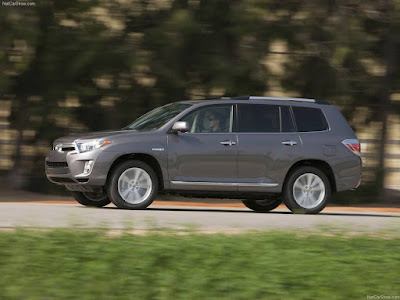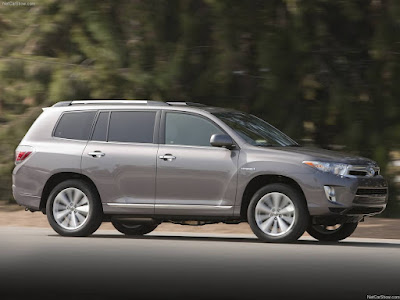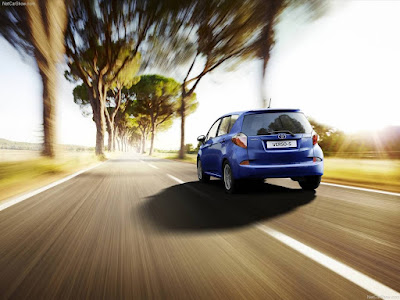








Toyota has significantly revised its popular Toyota Highlander and Highlander Hybrid crossover sport utility vehicles for 2011, giving them enhanced styling, additional standard amenities and new user technology.
The 2.7-liter four-cylinder engine, which was available only in the Toyota Highlander Base grade model for 2010, is now also offered in the SE, the most popular grade (2WD only). The Toyota Highlander Hybrid debuts a more powerful and advanced 3.5-liter V6 gasoline engine, along with a standard Tech Audio Package and unique exterior design elements.
The 2011 Highlander is available in Base, SE and Limited grades in both two-wheel (2WD) and full-time four-wheel-drive (4WD). A 270-horsepower 3.5-liter V6 is standard on the Limited grade and available for the others. All Toyota Highlander Hybrid models are equipped with four-wheel-drive with intelligence and available in Base and Limited grades.
The first-generation Toyota Highlander pioneered the midsize crossover utility vehicle segment, ushering in car-like performance, comfort and fuel efficiency yet with SUV-like roominess and versatility. The second-generation Highlander amplifies those attributes and is among the leaders in the segment in standard active and passive safety features.
New Styling Details for 2011
The Toyota Highlander gets a sophisticated design update for 2011 featuring a new front fascia, hood and fenders, with the profile freshened by black rockers with chrome accents (gas models only). The headlights and tail lamps are also redesigned, as are the 17-inch alloy wheels. The Limited Grade offers stylish 19-inch wheels and also features silver roof rails. The SE grade gains a power liftgate.
Toyota Highlander (2011)
The 2011 Highlander Hybrid is more easily distinguished from the gasoline model by its own unique grille and bumper design. It shares the new fenders and hood with the gas Toyota Highlander but features color-keyed rockers with chrome accents, plus vertically stacked fog lamps. The projector beam headlights and redesigned taillights feature blue lens covers. Daytime running lamps are now standard on all Toyota Highlander models.
Expanded Amenities and Tech for 2011
The Highlander remains a popular family vehicle and caters to that market more effectively for 2011 with more standard amenities and user technologies. In particular, Base and SE grades feature more comfort and convenience features than previously offered. A standard 50/50 split third-row seat and manual rear climate control have been made standard for all 2011 models.
The new Tech Audio is standard for SE and Limited and optional for Base grade and features a USB port, integrated XM Satellite Radio (includes 90-day trial subscription) and Bluetooth®, helping ensure a wide array of "connected" capabilities for passengers. In the Base grade, this is part of a more comprehensive package that also includes a backup monitor with 3.5-inch multi-information display, an eight-way power drivers seat, tonneau cover, engine immobilizer, easy-clean fabric interior, flip-up liftgate window, fog lamps and black roof rails.
The Toyota Highlander Hybrid base grade offers a new Leather Package that includes leather-trimmed front seats with front seat heaters, leather-trimmed steering wheel and shift knob, power moonroof, HomeLink®, auto-dimming rearview mirror with compass, plus an engine immobilizer with security alarm. The optional navigation system is now available for the SE grade (previously only on Limited), while the Limited gains standard automatic climate control for the rear and offers a new perforated leather. The Toyota Highlander Hybrid Base grade gains standard easy-clean fabric seating, along with an eight-way power driver's seat, the Tech Audio, the third-row seat and manual rear climate control.
Performance and Efficiency
The Toyota Highlander offers three distinct types of performance: a 2.7-liter four-cylinder engine joined the lineup in 2009, offering an EPA-estimated 25 MPG rating in highway driving. The 2.7-liter engine produces 187 horsepower and 186 lb.-ft. of peak torque.
The engine is equipped with a variable intake manifold and dual variable valve timing with intelligence (VVT-i), which controls phasing on both the intake and exhaust camshafts to optimize torque and fuel efficiency. The four-cylinder engine is teamed exclusively with a standard six-speed electronically controlled automatic transmission.
The available 3.5-liter V6 (standard on Limited) produces 270 horsepower at 6,200 RPM and 248 lb.-ft. of torque at 4,700 RPM. The V6, also, is equipped with dual VVT-i and a variable intake manifold. A five-speed electronically controlled automatic transmission (ECT) offers selectable manual sequential shifting.
The Toyota Highlander Hybrid model's Hybrid Synergy Drive features a new, more powerful 3.5-liter V6 for 2011, replacing the previous 3.3-liter V6. The system pairs the gasoline V6 engine with a high-torque electric drive motor-generator for total system output of 280 net horsepower. A second rear-mounted motor provides automatic on-demand four-wheel drive traction. The 2011 Highlander Hybrid receives EPA estimated fuel economy ratings of 28 MPG city and 28 MPG highway.
The 4WD Toyota Highlander Hybrid uniquely generates rear-wheel power with a separate electric motor (MGR) that provides additional drive torque on demand. Thus, the Toyota Highlander Hybrid 4WD-i system does not require power-transfer gearing or a driveshaft from the front. The system electronically varies front and rear torque distribution depending on traction conditions.
Activating an EV mode switch located on the front center console allows the driver to operate strictly in electric-mode under certain conditions for a limited distance at low speeds, or in some stop-and-go driving conditions. A new ECON drive mode switch activates a throttle control program that reduces the throttle response during acceleration, enhancing fuel economy. The Hybrid System Indicator in the instrument gauge panel provides the driver with a guideline to help maximize fuel consumption.
Handling and Ride
The Highlander continues to build on its strength of delivering one of the most capable, smooth and quiet rides in the segment. Four-wheel independent suspension is via MacPherson struts in front and a dual-link strut rear suspension system. Base and SE Highlander models are equipped with standard 17-inch alloy wheels with 245/65 R17 tires; the Limited features standard 19-inch alloy wheels with 245/55 R19 tires. A direct tire pressure monitoring system is designed to alert the driver if pressure in a tire drops to critical levels. All Toyota Highlander models are equipped with four-wheel disc brakes. On conventional Highlander 4WD models, full-time four-wheel drive is available on all V6 grades.
Active Safety
Toyota Highlander comes standard with Toyota's Star Safety System™. This system integrates operation of enhanced Vehicle Stability Control (VSC), Traction Control (TRAC), Electric Power Steering (EPS) and the anti-lock brake system (ABS), Electronic Brake-force Distribution (EBD), Brake Assist (BA).
Enhanced VSC helps the driver maintain control by automatically adjusting engine output and braking force at each wheel under certain conditions while also providing steering assistance in the appropriate direction through Electric Power Steering (EPS). Gasoline Toyota Highlander models are also equipped with a straight-line steering feature. When varying traction causes ABS to apply different left/right braking force, the system can apply steering torque to help offset left/right pull.
The Toyota Highlander Hybrid employs the advanced Vehicle Dynamics Integrated Management (VDIM) system. VDIM is designed to enhance handling, traction and braking systems that normally react to vehicle driving conditions by anticipating tire slippage before a skid, slide or wheel spin occurs and helps to make corrections in a smooth, progressive way. In addition to integrating all of the Highlander's dynamic control systems (VSC, TRAC, BA, EPS, EBD and ABS), the VDIM system also employs powerful proprietary software to integrate the Electronic Throttle Control with intelligence (ETC-i) and Electronically Controlled Brakes (ECB).
All Toyota Highlander models incorporate a corner-braking feature. Harnessing the integration of the vehicle's dynamic control systems, this feature limits brake pressure on inside wheels during cornering to help enhance control through the turn. Standard on all models, Hill-Start Assist Control helps prevent the vehicle from rolling backward from a stop by applying braking pressure for approximately two seconds.
Downhill Assist Control (DAC) is standard equipment on all gas 4WD models. The DAC feature is designed to maintain a constant speed and maintain handling and steering control by reducing wheel lock under braking even at slow speeds on slippery descents.
Occupant Safety
Toyota Highlander comes standard with seven airbags. These include advanced driver and front passenger airbags, front seat-mounted side airbags and a driver's knee airbag. Roll-sensing side curtain airbags help to protect the occupants of all three rows in the event of certain side collisions or vehicle rollovers. Additionally, all Highlander models are standard equipped with front active headrests.
Comfort and Convenience
Standard features on all Toyota Highlander models include front and rear air conditioning; eight-way adjustable driver's seat (10-way on Limited); power door locks and windows with driver's window jam protection and auto-up/down feature; manual tilt and telescopic steering wheel; cruise control; multi-function keyless entry system; UV-reduction windshield and rear privacy glass; digital clock; dual sun visors with vanity mirrors and sliding extensions; conversation mirror; illuminated entry system; scheduled maintenance indicator light; full-size spare tire and more.
The Highlander SE and Limited grades feature a standard backup camera with a 3.5-inch multi-information display; this feature is available for Base grade models for 2011 as part of the optional Tech Package. The display includes a backup camera monitor, clock, outside temperature, warning messages, and cruise information that includes average fuel economy, average speed, distance to empty, current fuel economy, and trip timer. On models equipped with the optional navigation system, the backup camera's images are viewed on the seven-inch navigation screen.
Options
A variety of available options and accessories include a voice-activated touch screen navigation system with an eight-inch screen; JBL premium audio; leather seat trim with heated front seats, and a power tilt/slide moonroof. The optional tow package for V6 models enables up to 5,000-pound maximum towing capacity. The four-cylinder tow package enables up to 3,500 pounds of maximum towing capacity. A power liftgate that can be opened and closed with a key fob is an available option on the Base grade and standard on SE and Limited.
Exterior Design
Designed at Calty Design Research in Newport Beach, Calif., the second-generation Toyota Highlander moves away from traditional SUV styling cues. Clean, sculpted lines, a wide, stable stance and muscular contours give Highlander a contemporary, dynamic presence. The Base grade Toyota Highlander could be mistaken for an upgrade model with its six-spoke 17-inch machined alloy wheels, color-keyed power remote outside mirrors, and silver-painted front grille. The Limited looks the luxury part with chrome door handles and roof rails, puddle lamps and rear spoiler.
Interior Design
The Toyota Highlander provides an open, airy and versatile interior with seating for seven or up to 95.4 cubic feet of total cargo capacity (94.1 for Highlander Hybrid). There are numerous storage compartments throughout the cabin, along with 10 cup holders, four bottle holders, two front and one cargo-area 12-volt auxiliary power outlets and cargo area tie down hooks.
The Base and SE grades feature a center console, shift knob with silver-painted accents and front driver and passenger assist grips. The center console, shift knob and assist grip on the Limited grade feature wood grain-style trim. Styling features on the inside of the Toyota Highlander Hybrid include a silver and wood grain-style interior trim with chrome door handle accents, Optitron meters with blue graphics and a power meter with a hybrid system indicator.
The headrests are adjustable in two ways on the Base grade and four different ways on SE and Limited. The second row provides 40/20/40 split seatbacks. The seat functions as either a three-person bench or, by removing the Center Stow™ seat, a pair of captain's chairs complete with armrests, creating a convenient walk-through area between the seats for easier access to the third row. A Center Stow™ center console can also be placed between the seats to provide additional storage. The second row also slides fore and aft and reclines.
Access to the third-row is made easy by placing the walk-in lever at an easy to reach position at the bottom of the passenger-side second-row seat. Standard one-touch levers inside the cargo area allow the second-row seats to fold forward and flat. The third-row seats function in a similar manner, using a lever in the back of the seat.
Production of the conventional engine Highlander, Toyota's 12th North American-built model, began in October 2009 at the company's plant in Princeton, Indiana. Moving the Toyota Highlander assembly line to this facility represented a $450 million investment.



































